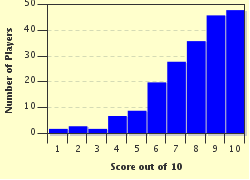Quiz Answer Key and Fun Facts
1. Used to hit a leather ball called a sliothar or a puck, a hurley stick was given to U.S. President Barack Obama by Taoiseach Enda Kenney on a visit to Ireland in 2011. In what Irish sport would you use this axe-shaped stick?
2. Traditionally crafted from the wood of hickory trees native to Canada and the USA, this stick has strings reinforced with resin in a triangular shape at its head. A ball may be "cradled" in this crossed netting as the player moves down the field or may be caught in it or propelled from it. What sport, played by both men and women, uses this sort of stick?
3. What Olympic sport uses an epee, a foil, and another specific piece of equipment to attack, feint, lunge, or parry?
4. In what sport does a batsman wield a bat with a flat blade, traditionally made from willow wood, attempting (among other things) to prevent a bowler from hitting a wicket?
5. In what team game does the player propel a ball down the field toward a goal, or defend their own goal, using a stick with a head that may be a shorti, a midi, a maxi, or a J hook?
6. While its modern equivalents have less colorful names, what sport once used brassies, cleeks, spoons, rakes, jiggers, mashies, niblicks, and (in Scotland) Sunday or Sabbath sticks?
7. Baseball at the professional level once used bats made of hickory, but later came to use the lighter weight but strong wood from ash and maple trees. What sport similar to baseball often uses bats of composite construction, with a metallic handle and a wooden barrel?
8. In what sport does equipment include brooms and stones or rocks, rather than balls and sticks?
9. What sport uses a stick (sometimes called a mallet) that has a shaft made of manau-cane; a head made from hardwood called tipa; and a webbed thong, called a sling, that wraps around the thumb?
10. Which sport, with origins in the Basque country of Spain, uses a fast-moving hard ball called a pelota and a scoop called a cesta, made of wicker or other basketry materials, which is strapped to the player's arm?
Source: Author
nannywoo
This quiz was reviewed by FunTrivia editor
gtho4 before going online.
Any errors found in FunTrivia content are routinely corrected through our feedback system.

